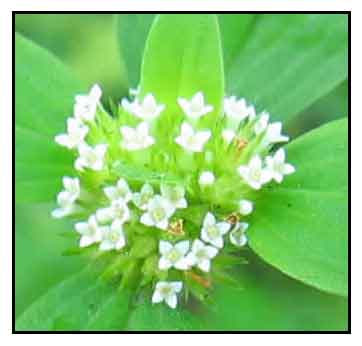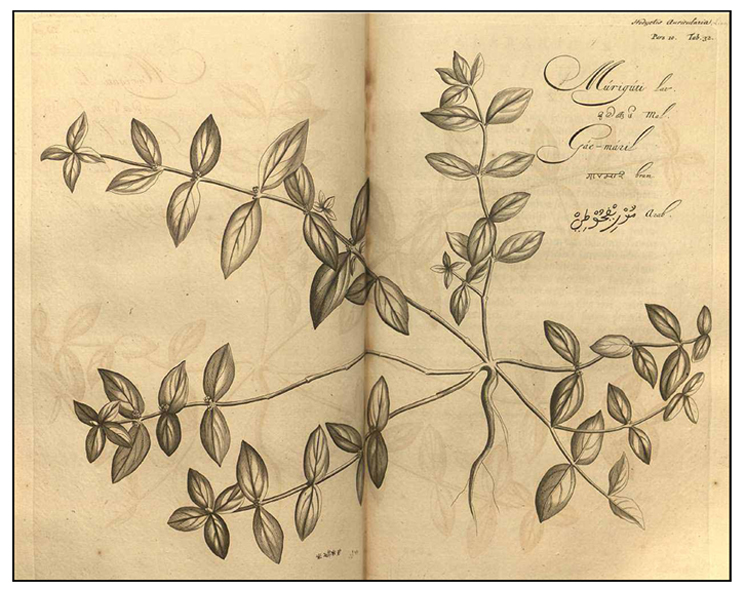
Family • Rubiaceae
Auricled hedyotis
Exallage auricularia (L.) Bremek.
EARED-LEAF DIAMOND FLOWER
Er cao
| Scientific names | Common names |
| Dimetia auricularia (L.) R.J.Wang | Auricled hedyotis (Engl.) |
| Exallage auricularia (L.) Bremek. | Auricular hedyotis (Engl.) |
| Hedyotis auricularia L. | Eared-leaf diamond flower (Engl.) |
| Hedyotis auricularia var. brevipila Fosberg & Sachet | Indian madder (Engl.) |
| Hedyotis auricularia var. dispersa Fosberg & Sachet | |
| Hedyotis auricularia var. longipila Fosberg & Sachet | |
| Hedyotis auricularia var. mina W.C.Ko | |
| Hedyotis auricularia var. tomentosa Fosberg & Sachet | |
| Hedyotis auricularia subsp. venosa (Blume) Deb | |
| Hedyotis costata R.Br. ex G.Don | |
| Hedyotis crataeogonum Spreng. | |
| Hedyotis geniculata Roxb. | |
| Hedyotis hirsuta Lam. | |
| Hedyotis lianshanensis W.C.Ko. | |
| Hedyotis multicaulis Schltdl. ex Hook.f. | |
| Hedyotis nervosa Lam. | |
| Hedyotis sarmentosa Craib | |
| Hedyotis venosa (Blume) Korth. | |
| Metabolos auricularis (L.) Blume ex Bremek. | |
| Metabolos ciliaris Blume ex Miq. | |
| Hedyotis venosus Blume | |
| Oldenlandia auricularia (L.) K.Schum. | |
| Oldenlandia auricularia var. macrophylla Pit. | |
| Oldenlandia crataeogonum (Spreng.) Guillaumin | |
| Oldenlandia leopoldvillensis De Wild. | |
| Spermacoce hispida Miq. ex Hook.f. | |
| Spermacoce lineata Roxb. | |
| Hedyotis auricularia L. is a synonym of Exallage auricularia. | |
| Exallage auricularia (L.) Bremek. is an accepted species. KEW: Plants of the World Online | |
| Other vernacular names |
| CHINESE: Er cao, Pu di zhan cao. |
| INDIA: Maslahari, Tharavu; Nela nekare (Kannada), Nela adaviaku (Telugu); Karimtharavu, Erachiketti (Malayalam); Aladana-ghanta (Sanskrit); Impooral (Tamil). |
| MALAYSIA: Kerekah batu, Kenikah batu. |
| SRI LANKA: Getakola (Sinhala). |
| THAI: Tong haeng. |
| VIETNAMESE: An dien tai, Ngoi tai. |
• Diffuse to trailing hers; stem 4-angled, bluish, villous when young. Leaves 2-7 x 1-2.5 cm, elliptic-ovate or elliptic-lanceolate, base rounded or cuneate, apex shortly acuminate, lateral nerves 4 or 5 pairs, glabrous; stipules broadly ovate, pectinate on margins. Flowers fascicled at axils; pedicels c. 1 mm long. Calyx tube c. 1 mm long, 4-lobed. Corolla white, campanulate; tube c. 1 mm long; lobes 4, reflexed, hairy at throat. Stamens 4, included. Capsule c. 2 mm across, globose, pubescent, indehiscent. Seeds many, black, 3-angled. (eFloraOfIndia) Distribution Constituents Properties Studies Availability |
Updated March 2025 / April 2014
![]()
 |
PHOTOS / ILLUSTRATIONS |
| IMAGE SOURCE: Illustration /Oldenlandia auricularia (L.) Schumann [as Hedyotis auricularia L.] Rheede tot Drakestein, H.A. van, Hortus Indicus Malabaricus, vol. 10: t. 32 (1690) / PlantIllustrations.org |
| OTHER IMAGE SOURCE: Hedyotis auricularia L. / Angla Stemmel Hedyotis / Click on image or link to go to source page / Plants of the Philippines |
| OTHER IMAGE SOURCE: Exallage auricularia / Manoj Karingamadathil / CC BY 4.0 / Image modified / Click on image or link to go to source page / India Biodiversity Portal |
Additional
Sources and Suggested Readings |
• |
DOI: It is not uncommon for links on studies/sources to change. Copying and pasting the information on the search window or using the DOI (if available) will often redirect to the new link page. (Citing and Using a (DOI) Digital Object Identifier) |
| List of Understudied Philippine Medicinal Plants |
| New plant names needed The compilation now numbers over 1,500 medicinal plants. While I believe there are hundreds more that can be added to the collection, they are becoming more difficult to find. If you have a plant to suggest for inclusion, native or introduced, please email the info: scientific name (most helpful), local plant name (if known), any known folkloric medicinal use, and, if possible, a photo. Your help will be greatly appreciated. |
• |
 |



 Uses
Uses 